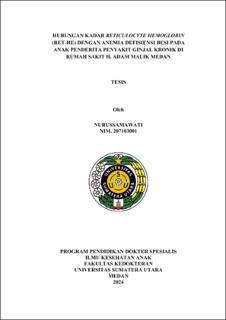| dc.contributor.advisor | Siregar, Rosmayanti Syafriani | |
| dc.contributor.advisor | Ramayani, Oke Rina | |
| dc.contributor.author | Nurussamawati, Nurussamawati | |
| dc.date.accessioned | 2025-06-12T07:35:03Z | |
| dc.date.available | 2025-06-12T07:35:03Z | |
| dc.date.issued | 2024 | |
| dc.identifier.uri | https://repositori.usu.ac.id/handle/123456789/104325 | |
| dc.description.abstract | Objectives: Iron deficiency anemia is a comorbidity that can increase the
mortality of children with chronic kidney disease (CKD). Diagnosis of iron
deficiency anemia in CKD is difficult because it requires a combination of
parameters that are influenced by inflammation, making it impractical and
expensive. The recommendation for a new parameter that is easier, cheaper, not
influenced by inflammation and has good diagnostic value is reticulocyte
hemoglobin (Ret-He). Reticulocyte hemoglobin is a measurement of the average
hemoglobin contained in reticulocytes, which are immature red blood cells that
have just been released from the bone marrow. Reticulocyte count itself is a good
parameter for quantitative aspects of erythropoiesis, but reticulocyte
hemoglobinization provides additional information about the quality of
erythropoiesis that directly reflects hemoglobinization.
Methods: This was an analytical observational study with a cross sectional design.
The sample was patients aged < 18 years who had been diagnosed with iron
deficiency anemia and chronic kidney disease at the polyclinic and inpatient
Adam Malik Hospital, Medan between January and April 2024. The patient had
blood drawn and then assessed at the clinical pathology laboratory. Data were
analyzed using SPSS Ver. 26 with the chi square statistical test (95% CI and
significance p<0.05).
Results: This research was attended by 51 children, 24 children with Ret-He
values ≤ 28,7 pg, there were 22 children (91.7%) who had iron deficiency anemia,
while of the 27 children with Ret-He values > 28,7 pg, only 3 children (11.1%)
had iron deficiency anemia. The results of the analysis using the chi square test
showed p-value <0.001 and prevalence ratio 8.250.
Conclusion: There is a significant relationship between the Ret-He value and iron
deficiency anemia in children with CKD at Adam Malik Hospital Medan. | en_US |
| dc.language.iso | id | en_US |
| dc.publisher | Universitas Sumatera Utara | en_US |
| dc.subject | chronic kidney disease | en_US |
| dc.subject | iron deficiency anemia | en_US |
| dc.subject | reticulocyte hemoglobin content | en_US |
| dc.subject | Ret-He | en_US |
| dc.title | Hubungan Kadar Reticulocyte Hemoglobin(Ret-He) dengan Anemia Defisiensi Besi pada Anak Penderita Penyakit Ginjal Kronik di Rumah Sakit H. Adam Malik Medan | en_US |
| dc.title.alternative | Relationship between Reticulocyte Hemoglobin Levels (Ret-He) and Iron Deficiency Anemia in Children with Chronic Kidney Disease at Adam Malik Hospital Medan | en_US |
| dc.type | Thesis | en_US |
| dc.identifier.nim | NIM207103001 | |
| dc.identifier.nidn | NIDN0001047106 | |
| dc.identifier.nidn | NIDN0001027401 | |
| dc.identifier.kodeprodi | KODEPRODI11711#Ilmu Kesehatan Anak | |
| dc.description.pages | 84 Pages | en_US |
| dc.description.type | Tesis Magister | en_US |
| dc.subject.sdgs | SDGs 3. Good Health And Well Being | en_US |


